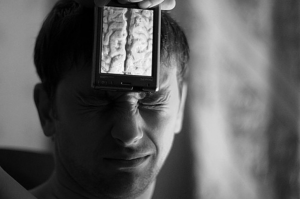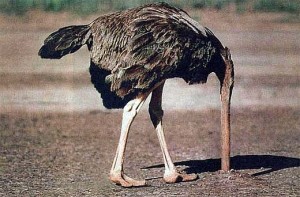Just keep smiling and scare that depression away
Time to do one of my favorite things today: talk about psychology research that failed to replicate. Before we get into that, though, I want to talk a bit about our emotions to set the stage.
Let’s say we wanted to understand why people found something “funny.” To do so, I would begin in a very general way: some part(s) of your mind functions to detect cues in the environment that are translated into psychological experiences like “humor.” For example, when some part of the brain detects a double meaning in a sentence (“Did you hear about the fire at the circus? It was intense”) the output of detecting that double meaning might be the psychological experience of humor and the physiological display of a chuckle and a grin (and maybe an eye-roll, depending on how you respond to puns). There’s clearly more to humor than that, but just bear with me.
This leaves us with two outputs: the psychological experience of something being funny and the physiological response to those funny inputs. The question of interest here (simplifying a little) is which is causing which: are you smiling because you found something funny, or do you find something funny because you’re smiling?
Intuitively the answer feels obvious: you smile because you found something funny. Indeed, this is what the answer needs to be, theoretically: if some part of your brain didn’t detect the presence of humor, the physiological humor response makes no sense. That said, the brain is not a singular organ, and it is possible, at least in principle, that the part of your brain that outputs the conscious experience of “that was funny” isn’t the same piece that outputs the physiological response of laughing and smiling.
The other part of the brain hasn’t figured out that hurt yet
In other words, there might be two separate parts of your brain that function to detect humor independently. One functions before the other (at least sometimes), and generates the physical response. The second might then use that physiological output (I am smiling) as an input for determining the psychological response (That was funny). In that way, you might indeed find something funny because you were smiling.
This is what the Facial Feedback Hypothesis proposes, effectively: the part of your brain generating these psychological responses (That was funny) uses a specific input, which is the state of your face (Am I already smiling?). That’s not the only input it uses, of course, but it should be one that is used. As such, if you make people do something that causes their face to resemble a smile (like holding a pen between their teeth only), they might subsequently find jokes funnier. That was just the result reported by Strack, Martin, & Stepper (1988), in fact.
But why should it do that? That’s the part I’m getting stuck on.
Now, as it turns out, your brain might not do that at all. As I mentioned, this is a post about failures to replicate and, recently, the effect just failed to replicate across 17 labs (approximately 1,900 participants) in a pre-registered attempt. You can read more about the details here. You can also read the original author’s response here (with all the standard suggestions of, “we shouldn’t rush to judgment about the effect not really replicating because…” which I’ll get to in a minute.
What I wanted to do first, however, is think about this effect on more of a theoretical level, as the replication article doesn’t do so.
Publish first; add theory later
One major issue with this facial feedback hypothesis is that similar physiological responses can underpin very different psychological ones. My heart races not only when I’m afraid, but also when I’m working out, when I’m excited, or when I’m experiencing love. I smile when I’m happy and when something is funny (even if the two things tend to co-occur). If some part of your brain is looking to use the physiological response (heart rate, smile, etc) to determine emotional state, then it’s facing an under-determination problem. A hypothetical inner-monologue would go something like this: “Oh, I have noticed I am smiling. Smiles tend to mean something is funny, so what is happening now must be funny.” The only problem there is that if I were smiling because I was happy – let’s say I just got a nice piece of cake – experiencing humor and laughing at the cake is not the appropriate response.
Even worse, sometimes physiological responses go the opposite direction from our emotions. Have you ever seen videos of people being proposed to or reuniting with loved ones? In such situations, crying doesn’t appear uncommon at all. Despite this, I don’t think some part of the brain would go, “Huh. I appear to be crying right now. That must mean I am sad. Reuniting with loved ones sure is depressing and I better behave as such.”
Now you might be saying that this under-determination isn’t much of an issue because our brains don’t “rely” on the physiological feedback alone; it’s just one of many sources of inputs being used. But then one might wonder whether the physiological feedback is offering anything at all.
The second issue is one I mentioned initially: this hypothesis effectively requires that at least two different cognitive mechanisms are responding to the same event. One is generating the physiological response and the other the psychological response. This is a requirement of the feedback hypothesis, and it raises additional questions: why are two different mechanisms trying to accomplish what is largely the same task? Why is the emotion-generating system using the output of the physiological-response system rather than the same set of inputs? This seems not only redundant, but prone to additional errors, given the under-determination problem. I understand that evolution doesn’t result in perfection when it comes to cognitive systems, but this one seems remarkably clunky.
Clearly the easiest way to determine emotions. Also, Mousetrap!
There’s also the matter of the original author’s response to the failures to replicate, which only adds more theoretically troublesome questions. The first criticism of the replications is that psychology students may differ from non-psychology students in showing the effect, which might be due to psychology students knowing more about this kind of experiment going into it. In this case, awareness of this effect might make it go away. But why should it? If the configuration of your face is useful information for determining your emotional state, simple awareness of that fact shouldn’t change the information’s value. If one realizes that the information isn’t useful and discards it, then one might wonder when it’s ever useful. I don’t have a good answer for that.
Another criticism focused on the presence of a camera (which was not a part of the initial study). The argument here is that the camera might have suppressed the emotional responses that otherwise would have obtained. This shouldn’t be a groundbreaking suggestion on my part, but smiling is a signal for others; not you. You don’t need to smile to figure out if you’re happy; you smile to show others you are. If that’s true, then claiming that this facial feedback effect goes away in the presence of being observed by others is very strange indeed. Is information about your facial structure suddenly not useful in that context? If the effects go away when being observed, that might demonstrate that not only are such feedback effects not needed, but they’re also potentially not important. After all, if they were important, why ignore them?
In sum, the facial feedback hypothesis should require the following to be generally true:
- (1) One part of our brain should successfully detect and process humor, generating a behavioral output: a smile.
- (2) A second part of our brain also tries to detect and process humor, independent of the first, but lacks access to the same input information (why?). As such, it uses the outputs of the initial system to produce subsequent psychological experiences (that then do what? The relevant behavior already seems to be generated so it’s unclear what this secondary output accomplishes. That is, if you’re already laughing, why do you need to then experience something as funny?)
- (3) This secondary mechanism has the means to differentiate between similar physiological responses in determining its own output (fear/excitement/exercise all create overlapping kinds of physical responses, happiness sometimes makes us cry, etc. If it didn’t differentiate it would make many mistakes, but if it can already differentiate, what does the facial information add?).
- (4) Finally, that this facial feedback information is more or less ignorable (consciously or not), as such effects may just vanish when people are being observed (which was most of our evolutionary history around things like humor) or if they’re aware of their existence. (This might suggest the value of the facial information is, in a practical sense, low. If so, why use it?)
As we can see, that seems rather overly convoluted and leaves us with more questions than it answers. If nothing else, these questions present a good justification for undertaking deeper theoretical analyses of the “whys” behind a mechanism before jumping into studying it.
References: Strack, F., Martin, L. L., Stepper, S. (1988). Inhibiting and facilitating conditions of the human smile: A nonobtrusive test of the facial feedback hypothesis. Journal of Personality and Social Psychology, 54, 768–777
Wagenmaker, E. et al (2016). Registered replication report: Strack, Martin, & Stepper, (1988). Perspectives on Psychological Science, 11, https://doi.org/10.1177/1745691616674458
































